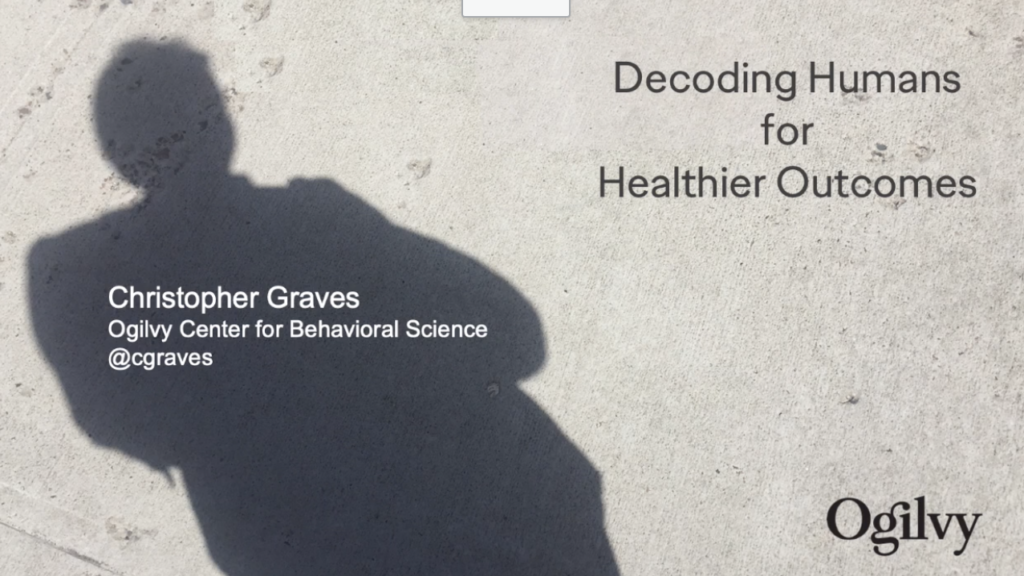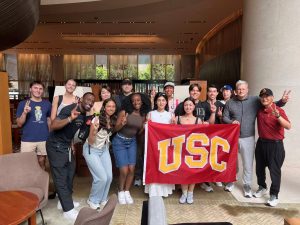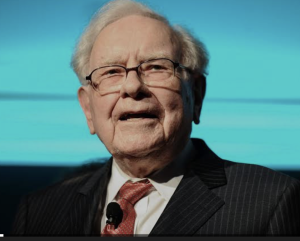Today’s Monday Morning Mojo is coming to you at this time because I am now on China Standard Time as I write from quarantine in Shanghai, China.
We have the great honor of having Chris Graves, my former boss and one of the smartest people I know, help explain to us the booming practice of Behavioral Science. Chris is now President and Founder and of the Ogilvy Center for Behavioral Science and he has won numerous awards for his work. If you want to understand more deeply what is happening in our world and why, read on. You can learn more about this by spending a valuable ten minutes of your time listening to Chris’ explanation. Thanks for reading and have a great week ahead.
What is behavioral science? Why should we be using it?
Why do people not act in their own best interests? Why do people make dodgy decisions, despite no end of information to evaluate? Why do people divide along violent, deep rifts over things like wearing a mask in a pandemic? Why do people find saving money, dieting or taking personal actions to help slow climate change so very difficult?
Behavioral science has begun to reveal the reasons and suggest remedies. But what is behavioral science? It is a combination of many other fields, such as: behavioral economics; social psychology; cognitive psychology; neuroscience; evolutionary psychology; personality trait science and more. Behavioral economics took the early lead with visionaries such as Daniel Kahneman, Nobel Laureate and author of “Thinking Fast and Slow.” Kahneman and his research partner, Amos Tversky, delved into the mysteries of why traditional economics did not explain human behaviors. He surfaced a collection of bugs in our software (our brains) that help us do speedy choices, but choices that can be flawed or downright wrong. Later, scientist-authors such as Cass Sunstein and another Nobel prize winner, Richard Thaler, wrote the seminal guide “Nudge.” It showed how small interventions or changes in how choices are framed make all the difference in the outcomes. It turns out that we humans don’t often decide between two options (or more)—we decide between how those options are positioned or framed.
The great scientist-author Dan Ariely calls our species “Predictably Irrational” because of this (see his book by the same title).
I prefer to think we are not irrational so much as out of date. Our human software (our brains) was wired long ago and changes slowly. It was wired to survive a hostile environment so we could kill or runaway, eat and reproduce. That last task is most important in evolution. That hostile environment meant we put all decision-making premiums on speed. We could act fast and be wrong yet still survive. But if we act too slowly we’re toast. So we were wired for a basic survival in a world of dirt. But today, that same human software tries to cope with hugely complicated and complex challenges.
We are wired for dirt but live in digital. This disconnect of a slowly evolving brain coping with our environment changing at the speed of artificial intelligence, quantum computing…and merely figuring out savings or insurance plans, leads to software bugs in our decision-making and behavior. These bugs are called “cognitive biases.”
Behavioral science has catalogued these cognitive biases and mapped them to show how they affect our decision-making and behaviors. For example, as a species, we are usually present biased. We always prefer a smaller reward immediately to a bigger payoff later. That affects our savings, our diets and whether we do sensible things now for a better outcome years later (we don’t). As a species we are also supremely optimistic and over-confident. That leads us to underestimate the time or difficulty of challenges and overestimate our ability to cope or avoid dangers. There are hundreds of such cognitive biases.
Deeper into the inner workings of individuals.
Beyond these cognitive biases, there are a host of hidden wirings in each human that guide, filter and shape our behaviors. I have worked for about five years to create a new kind of research instrument to decode these inner wirings using three lenses. This invention has just won its 6th global award.
The first is personality trait science. Each of us inherits about half our personality. Each of the five factors that make up our personality come together in a kind of hidden blueprint that determines how we behave and make sense of the world. When we craft language, offers, message framing or creative to resonate with a specific personality profile, it works better.
By decoding and mapping these, we can create software patches and workarounds for our buggy human brains and arrive at better choices and healthier outcomes. But it also revolutionizes our approach to engagement, marketing, advertising and PR. It moves us from a kind of warlike targeting to a more empathetic decoding of others.
The second is called “cultural cognition” or worldview. It refers to how our identity is tied to how we view the world and how we think things should work and how people should act. It explains why we can be deeply divided over issues or even simple things like wearing a mask in a pandemic.
The third lens is a basket of effects called “cognitive styles.” They include things like whether you prefer making sense of things through facts and data, or through stories. Whether your decision-making is guided more by an urge to try new things, attain new goals or to avoid harm and stick with what you know is safe.
How can we use behavioral science?
We use this new research instrument to do “cognitive segmentation,” which is decoding individuals at scale and then see what kind of messaging or creative resonates best with which profiles. It differs from traditional research because it can have very little to do with demographics, and we do not believe what people tell us in terms of why they made certain choices or why they behave certain ways. That is a big flaw in some qualitative stated preference research and focus groups.
We use the findings to create a new kind of journey map, with cognitive biases tied to each stage. We create better communications versioning and planning to match the new profiles.
There are very specific findings in behavioral science that should inform communicators and creatives and move them off some very old, traditional but wrong approaches.
For example, which works better—to tell a story about one, single individual or a group? The answer is definitive and comes from long research into the “identifiable victim effect.” We always pay far more attention to and exhibit more sympathy and empathy for a richly detailed story about one single individual (whether they are a victim or not). For years, journalists and activists wrote about the growing size and dangers of Syrian refugees and not much attention was paid. Then the photo of one small Syrian boy, drowned and washed up on the beach in Turkey made the front page of every newspaper, every website and blog and newscast in the world. Searches on Google for refugees skyrocketed.
Communicators, especially high-level executives, professionals, and experts in areas like finance and health go wrong when they speak in abstractions. Behavioral and neuroscience inform us that the brain deals better with very specific, vivid, concrete imagery than abstractions. We believe and trust the concrete speaker more. Yet to sound smart, people go back to using abstract language. You must make a picture in the reader or listener’s mind to be effective.
For the past four years, I have been working in the challenge of “vaccine hesitancy.” Then, when the pandemic hit, I supported WHO, UNICEF, Save the Children, the city of New York, the city of Chicago and many others. Sometimes people are reluctant to get vaccinated because they do not really know how a vaccine works. They may think it gives you the disease, for example. So I retold the story of how vaccines work using sports and Star Wars. Make it concrete and easy to picture.
There are many, many very practical tips from behavioral science that could improve communications.
The future of behavioral science.
This umbrella field is taking off. PhD programs are everywhere. Companies now have their own BeSci or “nudge” units. It is being deployed in health, finance, environment, and consumer marketing. I assume, like many new areas, people will go overboard and make too many promises and overreaching claims. Some will be embarrassed or get burned. It may ding the whole field within agencies. I have found scaling up behavioral science in an agency is hard. It takes time and you cannot cheat. You keep coming back to a very deep and fast-growing science. We are trying to scale up now by both hiring and by growing our internal community of practice.
In terms of the world and the impact of behavioral science, it will be used for good and for bad, for health and for exploitation. Today you can record someone talking and decipher their inner wiring and personality traits using artificial intelligence. You can use machine learning to infer someone’s personality from their Instagram posts. So it will probably need to be regulated.
Unfortunately, when I asked Nobel Laureate Daniel Kahneman whether we will all get a bit more civilized, more empathetic, more tolerant due to understanding these biases and hidden wirings, he laughed and said, “that makes perfect sense… but no. We remain just as biased.”





Thank you Scott for sharing this informative piece of work. I am hopeful that humankind will at least loosen up a bit on our biases! We would all benefit from not being so rigid in our thinking! My mother taught me to try and put myself in the other person’s shoes! So I do try!
Thank you Scott for sharing it! Chris has been teaching us this killer science for years and still said that: “I have found scaling up behavioral science in an agency is hard. It takes time and you cannot cheat. You keep coming back to a very deep and fast-growing science. We are trying to scale up now by both hiring and by growing our internal community of practice.” – We must step up and speed up!
Abstractions versus visualized ideas that make people act. Such a beautiful insight into people. Thank you Scott Kronick, Chris Graves for succinct pearls of wisdom.
This is great, Scott. I have always been awed and impressed by the work Chris is doing. Thank you for posting
Great read Scott. Always a Masterclass of reference with Chris’ thinking. The challenge of human software updates maybe helps explain the resilience, lack of inclusion and mental well-being challenges many employers are wrestling.
Brilliant as always Chris.
Recommendable post. I learn something more challenging on different blogs everyday. Helpful stimulating to see content from other writers and study a little something there. Let me apply certain of your content on my blog on hand mind. Natually Ill give you a link time for your web page. Appreciate your sharing.